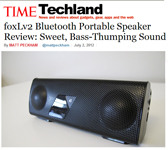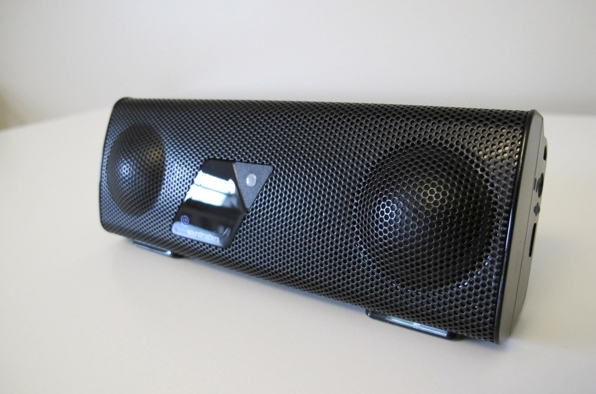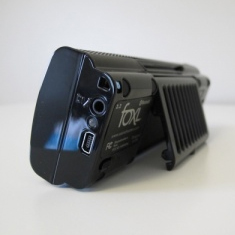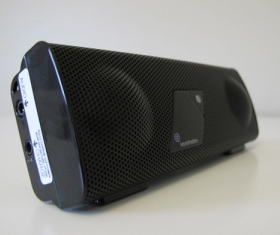|
|
Time Magazine on
foxL: "The foxLv2 is easily the best-sounding pocket-sized 2.1-channel audio
playback device I’ve ever tested," - Matt Peckham, Time Magazine
By
Matt Peckham,
Time Magazine 
foxLv2 Bluetooth
Portable Speaker Review: Sweet, Bass-Thumping Sound
By Matt Peckham | July 2, 2012

I’m usually not
susceptible to stunt-pitching, but when the speaker wonks at Soundmatters
lobbed an email for the company’s $200
foxLv2 portable
Bluetooth speaker at the universe with a blurb from The Great Kat, well…
I wasn’t expecting to see that name again, 20 years after first running
across it in a post-Yngwie Malmsteen funk. The Great Kat? Of
“Beethoven on Speed” fame? Using it as a traveling practice amp? Mission
accomplished! I asked to give the baseline model a whirl.
Alas, I can’t endorse it as a traveling wireless practice amp, because you’d
need a Bluetooth instrument like a guitar or keyboard, and those don’t
really exist (nor, given all of Bluetooth’s audio idiosyncrasies, is that
tech coming anytime soon).
But I’ve been playing with the foxLv2 for a week now, and I can say it’s
easily the least problematic, best more-than-decent-sounding ultraportable
wireless speaker for laptop or mobile phone music and wired instrument
playback I’ve laid ears on. In fact — spoilers! — my only real quibble with
the speaker is its name, which sounds more like a generic spaceship in a Kim
Stanley Robinson novel than what’s supposed to be a hip, high-end,
pocket-sized speaker.
Out of the Box
The foxLv2 unit itself, or “foxL version 2″ – the original version debuted
in 2008 — is about the length of a small TV remote and roughly twice as
thick. It’s also twice as heavy, probably due to its pair of one-inch linear
magnetic drive speakers, dubbed “Twoofers” by Soundmatters. The whole thing
weighs 269 grams, or a little more than a can of soda. I don’t subscribe to
the “quality by weight” school of thought, but this thing has definite heft
for its size — 5.6 x 2.2 x 1.4 inches — so if it matters, consider that box
checked.
The dome-style stereo speakers themselves bulge ever-so-slightly from the
foxLv2′s left and right side, covered by a rigid metal-like (but actually
glass composite) mesh with a beehive pattern and openings small enough to
keep the insides well-protected from all but the smallest particles. The
speakers are just shy of three inches apart, offering basic stereo
separation, though the stereo field itself is obviously much smaller.
Between the speakers sits a trapezoidal shape bearing the Soundmatters logo
and a pairing button that doubles as a light indicating Bluetooth
connectivity by blinking fast or slow. Just to the right of this lies a
noise canceling microphone (yes, an actual microphone) in the event you want
to use the thing as a monaural Bluetooth speakerphone. I didn’t do much
serious testing of the mic, but in several iPhone 4-based conversations, the
people I called had no problem hearing and understanding me, but complained
of unusually loud and continuous background noise. I’m not sure I’d bother
with it, given most of the kinds of devices — computers, smartphones — you’d
connect to the foxLv2 already have their own respectable speakerphone
options.

On the right side (facing the speaker) you have a mini-USB connector for
charging a battery that’s rated for up to six hours of continuous audio
playback via Bluetooth or 12 hours direct-wired, an LED charge indicator and
a 3.5mm stereo mini-jack for connecting an external subwoofer. On the left,
there’s a 5V power input and another 3.5mm stereo mini-jack for connecting
other audio devices, say you want to plug in an instrument or just bypass
Bluetooth and run direct from your computer or mobile phone.
The foxLv2 comes with both USB and AC power cables, a 3.5mm audio cable, a
cinch-tie soft case and carrying strap, a rubber placement mat (to keep it
from vibrating around the table), as well as international plug adapters,
say you want to carry the foxLv2 with you abroad.
Flip the foxLv2 around and you’ll find the power switch, manual volume
up/down buttons and a hinged grille you can flip open like the brace on the
back of a picture frame to provide extra stability. Not that the speaker
really needs it — even with the grille tucked flush against the back, it
feels reasonably stable with its two nearly inch-long rubber feet pitching
the frame slightly up, the speakers aimed out at about a 45-degree angle and
all of that resting on the unit’s slightly narrower back piece.
Setup
Power the foxLv2 on and you’ll hear a quiet beep (much less annoying than
the HMDX Jam‘s), after which it’ll attempt to establish a device link.
Pairing the foxLv2 to my Retina MacBook Pro was a snap using Apple’s
Bluetooth Setup Assistant — you’ll need a device that’s A2DP (advanced audio
distribution profile capable, stereo audio, one-way) compatible, which
includes nearly all mobile phones and laptops of recent vintage.
Since I have several other audio devices connected to my computer (an Apogee
One, an M-Audio FastTrack Pro) I had to manually tell the computer to “Use
as Audio Device,” after which the foxLv2 usually did as instructed. I did
experience occasional Bluetooth audio pops and clicks, though far less
frequently than with the HMDX Jam — your mileage may vary, since this is an
ongoing issue with Bluetooth itself. Also: The foxLv2 was selectable in OS
X’s audio output dialogue box in either stereo and non-stereo
configurations, but the non-stereo option produced badly attenuated playback
sound, so you’ll (obviously) want the stereo option, which is where the
foxLv2 shines.
I did have some odd re-pairing issues, where after a few minutes of
inactivity the foxLv2 would beep and power down. All well and good, but
initiating Bluetooth audio playback after this happened resulted in error
messages saying the Bluetooth device wasn’t available. I had to manually
power the foxLv2 off and back on to get it to reconnect properly.
When you fire up a track in iTunes, the foxLv2 emits another low beep, then
— after the usual 1-2 second wakeup delay — begins playing the selected
song. I tested listening intermittently to lossless audio versions of Muse’s
“Apocalypse Please,” Michael Jackson’s “Wanna Be Startin’ Somethin’,”
Phish’s “Llama,” Glenn Gould’s performance of Bach’s Partita No. 1 and
Medeski, Martin & Wood’s “Bubblehouse” to put the speakers through their
paces.
Sweet Bass-Thumping, (Mostly) Distortion-Free Sound
High- and mid-range audio was generally clear and well-articulated, though
the mid-range sometimes sounded over-boosted or slightly hollow when
compared to playback through my flat M-Audio D2 studio monitors,
foregrounding the hammering piano and Matthew Bellamy’s vocals in
“Apocalypse Please” at the expense of Christopher Wolstenholme’s relentless
bass line. If you do elect to bypass Bluetooth and go with a direct 3.5mm
cable connection, the audio quality definitely improves, to the point that
my criticism of the mid-range evaporates. But it’s probably the foxLv2′s
ability to carry off bass-heavy music at high amplitudes with little audio
distortion that’s most impressive about this little speaker.

The rear grille sits in front of something Soundmatters calls a
“BassBattery” — a piece of rubber that’s actually a miniature version of the
company’s “moving-wall” passive bass radiators, which it employs in its line
of subwoofers. And here’s the clever part: the lithium-ion battery is
actually inside the rubber, allowing it to be both a woofer and double as an
acoustic suspension bass driver (thereby reducing bass distortion).
According to Soundmatters: “Moving the battery from the inside of the
speaker to become part of a ‘moving-wall’ radiator, frees up critical
internal airspace to drive the bass.”
Crank up anything by acid jazz/funk group Medeski, Martin & Wood and the
foxLv2 really struts its stuff, sending big, clean, thumping bass and drums
(no muddiness here) throbbing through whatever object you’ve set the unit on
without a trace of mid- or high-frequency distortion. You can really crank
this thing to impressive levels, easily filling a mid-sized room, especially
if you’re running off AC power, which “doubles” the system’s power — 4 watts
on battery versus 8 watts off AC — and mitigates the likelihood of its
“protection circuit” kicking in (it’ll do so at high playback levels to
protect the speakers,
according to Soundmatters’ FAQ).
I tested in a large room with 10-foot ceilings using both Bluetooth and
wired audio and had no problems hearing the foxLv2 from any point in the
room. The audio can warp slightly at the foxLv2′s amplitude threshold, i.e.
source and unit levels jacked, but assuming you’re not planning to use this
thing for a rave and you run it at moderate volume levels, it’s completely
distortion-free.
Conclusion
And so we come to the name. Why not something sexy, like “Jambox” or “SoundLink”?
I mean, “foxLv2″? Who names their prestige “personal audiophile loudspeaker”
speaker after something that sounds like the Sector X level in a 1993
Nintendo game, or maybe the elite black ops group in Konami’s Metal Gear
Solid?
Okay, so it’s actually the name of Soundmatters’ founder Dr. Godehard
Guenther’s grandson, which officially qualifies it as endearing. It just
feels like it needs a little something extra. “FoxBox”? “FoxRox”? (I know,
don’t hire me all at once.)
Kidding aside, the foxLv2 is easily the best-sounding pocket-sized
2.1-channel audio playback device I’ve ever tested, slightly smaller and
notably clearer-sounding than Jawbone’s $200 Jambox (and a lot smaller than
the improved-sounding but more expensive $300 Big Jambox). The irony:
Soundmatters says it supplies the audio technology inside all of Jambox’s
speakers.
Alternatively, Soundmatters offers a $150 version of the foxLv2 that’s
wired-only (no Bluetooth), if you’d rather not grapple with Bluetooth’s
idiosyncrasies, and there’s also a $250 “platinum” model with even better
battery life that uses aptX’s “CD-quality” Bluetooth streaming technology
(I’ll be testing the latter shortly).
The contents of all photos, graphics,
and text are protected by copyright
and may not be used or reproduced
without prior express written authorization from the publisher.
|




